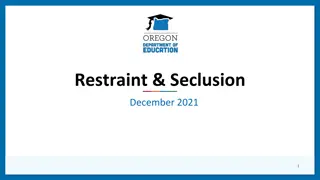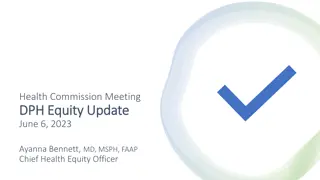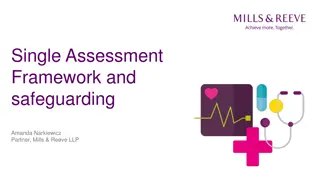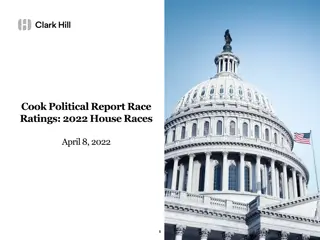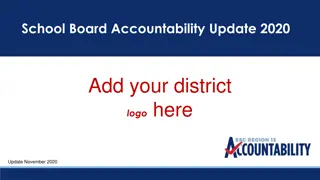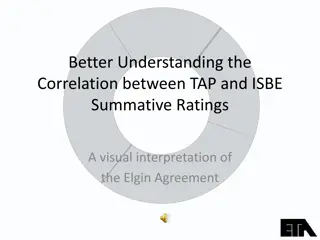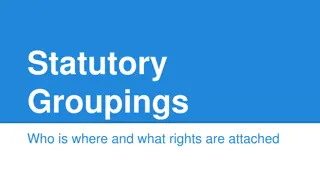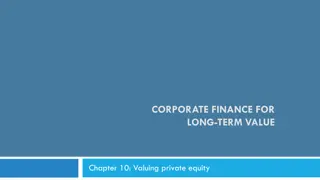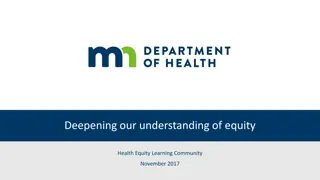Understanding School Ratings for Equity in Education
School ratings play a crucial role in promoting equity in education by setting clear criteria for high-performing schools and prompting action for underperforming ones. This article highlights the importance of rating criteria design in revealing or concealing educational disparities, discusses key decisions states must make in creating or modifying accountability systems, and raises questions on measuring performance, progress, and consistency across student groups. Through examples and explanations, it emphasizes the need for equitable approaches in evaluating school performance.
- School Ratings
- Equity in Education
- Accountability Systems
- Educational Disparities
- Student Performance
Download Presentation

Please find below an Image/Link to download the presentation.
The content on the website is provided AS IS for your information and personal use only. It may not be sold, licensed, or shared on other websites without obtaining consent from the author. Download presentation by click this link. If you encounter any issues during the download, it is possible that the publisher has removed the file from their server.
E N D
Presentation Transcript
SUBTITLE October 20 21, 2016 Omni Houston Hotel at Westside Houston, Texas ESSA Boot Camp | October 2016
School ratings can be a powerful tool for School ratings can be a powerful tool for equity equity By defining what it means to get an Excellent or a Good rating, rating criteria can make clear that to be considered a high-performing school, a school has to be serving all of its students not just some well. Excellent Good Acceptable By identifying schools that are not meeting expectations for one or more groups of students, ratings can prompt action and help districts and states better target resources and supports. Needs Improvement Struggling ESSA Boot Camp | October 2016
But the way rating criteria are But the way rating criteria are designed can make the designed can make the difference between difference between illuminating educational illuminating educational disparities disparities or hiding them. or hiding them. ESSA Boot Camp | October 2016
Goals of session Talk through key decisions states have to make if they are either creating a new accountability system, or making really big changes from their existing one. Identify questions to ask about these decisions in your state; and Highlight potential ways good and bad that states could approach making those decisions. ESSA Boot Camp | October 2016
To be clear There are way more decisions that go into an accountability system than we ll talk about. But we ll try to highlight key points that are especially important for equity. There multiple good ways to make each decision, and multiple bad ways. We ll talk about some examples but there s no way we can be exhaustive. ESSA Boot Camp | October 2016
So, what are those key decisions states will have to make? How do we combine these measures into a rating? How do we include both performance and progress? What are our expectations on each of these measures? What are we going to measure? How much should different indicators weigh? How do we include results for all groups of students? How do we define consistently underperforming ? ESSA Boot Camp | October 2016
To help us walk through all of these decisions, let s use an example school Wilson Middle has 800 students in grades 6-8 Student demographics 100% 100 90% Latino 13% 80% 350 70% 60% Black 25% White 62% 50% 700 40% 30% 450 20% 10% 0% Low Income Student with a disability Disclaimer: Wilson Middle is fictional. But it s not atypical. No Yes ESSA Boot Camp | October 2016
What are we going to measure? What are we going to measure? ESSA Boot Camp | October 2016
The state where Wilson Middle is located has The state where Wilson Middle is located has chosen to look at the following indicators**: chosen to look at the following indicators**: Achievement: Percent of students on grade level in reading, math and science Adequate growth: Percent of students making sufficient progress to get to grade level, or stay at grade level in reading and math Percent of ELs making progress toward English language proficiency: Note: Does not apply to this school (not enough English learners) Additional indicator of school quality (1): Percent of 8th graders successfully completing Algebra 1 (passing end-of-course assessment) Additional indicator of school quality (2): Percent of students suspended or expelled ** Note: Not a recommendation. We just needed to pick some metrics. ESSA Boot Camp | October 2016
What are our expectations on each of the What are our expectations on each of the measures? measures? ESSA Boot Camp | October 2016
How is Wilson Middle doing on these indicators? 69% Are on track to reach or stay at grade level by graduation. 69% of students Met grade level standards in reading 72% of students Met grade level standards in math 62% of students Met grade level standards in science 76% of students Made adequate growth in reading 64% of students Made adequate growth in math Are these results good? Acceptable? Bad? 42% of students Took and passed Algebra 10% of students Were suspended or expelled ESSA Boot Camp | October 2016
Take reading, for example 69% of students met grade level standards in reading at Wilson middle school. If the state average is 50%... Would you think this was good or bad? What if the state average was 90%? Wilson reading passing rate compared to state average of 90% Wilson reading passing rate compared to state average of 50% 100% 90% 100% 90% 90% 80% 69% 80% 69% 70% 70% 60% 60% 50% 50% 50% 40% 40% 30% 30% 20% 20% 10% 10% 0% 0% Wilson Reading Passing Rate State Average Wilson Reading Passing Rate State Average ESSA Boot Camp | October 2016
Now lets make things more complicated Because behind each of these school-wide averages are vastly different results for each group of students. Math Passing Rate, by student group Percent suspended or expelled, by student group 90% 35% 84% 30% 80% 72% 30% 70% 63% 25% 25% 57% 60% 20% 47% 50% 20% 40% 15% 11% 30% 10% 21% 10% 20% 10% 5% 2% 0% 0% All Students White Black Latino Low Income Students with Disabilities All Students White Black Latino Low Income Students with Disabilities ESSA Boot Camp | October 2016
Oh, and remember that one years worth of data only tells us so much For example, results in reading at this school have been going up, both overall and by group. In math, the trends are much more mixed. Reading passing rate by group over 3 years Math passing rate by student group over 3 years 100% 100% 80% 80% 60% 60% 40% 40% 20% 20% 0% 0% Year 1 Year 2 Year 3 Year 1 Year 2 Year 3 All students White Black Latino Low Income Students with Disabilities All Students White Black Latino Low Income Students with Disabilities ESSA Boot Camp | October 2016
Having clear expectations for both performance and improvement and improvement is critical to making sense of all this information. both performance ESSA Boot Camp | October 2016
Key principles: Expectations Key principles: Expectations Schools should know what they are expected to do before the school year begins to reach a certain rating. Expectations should be rigorous. Expectations for performance should be the same for all groups of students. Expectations for improvement should demand more gains for groups of students who are further behind. ESSA Boot Camp | October 2016
Questions to ask about performance expectations Questions to ask about performance expectations ESSA Boot Camp | October 2016
Do schools know how they are expected to perform Do schools know how they are expected to perform before the school year begins school year begins to reach a certain rating? to reach a certain rating? before the Has the state set specific performance thresholds for each indicator? (see example) Is that information available the summer before school starts? Percent on grade level Points awarded 80% or greater 5 points 65 80% 4 points 55 - 65% 3 points 45 55% 2 points Less than 45% 1 point Things to watch out for: The state doesn t set expectations for each indicator. This makes it harder for schools to figure out what they need to do to get a particular rating. The state bases ratings or points based on school rankings. This means that a school s rating depends not just on how it performs, but on how other schools perform. ESSA Boot Camp | October 2016
Are expectations rigorous? Are expectations rigorous? What percent of schools earns each amount of points (or each rating) based on results for all students? How about each group of students? i.e. If half of schools are reaching the top level of performance, the expectations are probably not high enough. ESSA Boot Camp | October 2016
Are expectations for performance the same for Are expectations for performance the same for all groups of students? all groups of students? The state should have one set of performance thresholds that apply to all groups of students. You want to see this: And NOT this: Graduation rate needed to earn Graduation rate needed to earn Student Group 5 points 4 points 3 points 2 points 1 point Student Group 5 points 4 points 3 points 2 points 1 point All students 95 % and over 85-94 % 75-84 % 67-74 % Below 67 % All students 95 % and over 86-94 % 76-85 % 67-75 % Below 67 % Black 95 % and over 85-94 % 75-84 % 67-74 % Below 67 % Black 90 % and over 84-89 % 74-83% 65-73 % Below 65% Latino 95 % and over 85-94 % 75-84 % 67-74 % Below 67 % Latino 87 % and over 79-86 % 72-78 % 62-71 % Below 62 % Native 95 % and over 85-94 % 75-84 % 67-74 % Below 67 % Native 85 % and over 76-84 % 67-75 % 59-66 % Below 59 % Asian 95 % and over 85-94 % 75-84 % 67-74 % Below 67 % Asian 96 % and over 89-95 % 78-88 % 69-77 % Below 69 % White 95 % and over 85-94 % 75-84 % 67-74 % Below 67 % White 97 % and over 88-96% 80-87 % 71-79 % Below 71 % Low Income 95 % and over 85-94 % 75-84 % 67-74 % Below 67 % Low Income 87 % and over 79-86 % 70-78 % 62-69 % Below 62 % Students with Disabilities 95 % and over 85-94 % 75-84 % 67-74 % Below 67 % Students with Disabilities 75% and over 68-74 % 59-67 % 50-58 % Below 50% English learners 95 % and over 85-94 % 75-84 % 67-74 % Below 67 % English learners 77 % and over 71-76 % 62-70 % 52-61 % Below 52 % ESSA Boot Camp | October 2016
Are expectations for performance the same for Are expectations for performance the same for all groups of students? all groups of students? Watch out for: Attempts to compare results for a group of students with other schools results for the same group. For example, calling a school high performing because its low-income graduation rates are in the top 10% of graduation rates for that group. Or conversely, only calling a school low-performing for a group if it s in the bottom 10% (or 20, or 30%) of the group s results. ESSA Boot Camp | October 2016
For our example, were setting the following thresholds, which apply to For our example, we re setting the following thresholds, which apply to results for all students and each student group: results for all students and each student group: Percent earning High School Credit Percent Proficient- Reading Percent Proficient - Math Percent Proficient - Science Adequate Growth - Reading Adequate Growth - Math Percent suspended or expelled 5 Points >71% >70% >75% >68% >64% <2% >53% 4 Points 56%-71% 54% - 70% 61%-75% 58%-68% 45%-64% 2%-8% 44%-53% 3 Points 47%-55% 42%-53% 50%-60% 40%-57% 37%-44% 9%-13% 32%-43% 2 Points 33%-46% 31-41% 40-49% 27%-39% 24%-36% 14%-21% 19%-31% 1 Point <33% <31% <40% <27% <24% >21% <19% ESSA Boot Camp | October 2016
Heres how Wilson is doing against these expectations Preliminary Performance Points Students with Disabilities Low Income All White Black Latino Percent meeting grade-level standards - Reading Percent meeting grade-level standards - Math Percent meeting grade-level standards - Science Percent making adequate growth - Reading Percent making adequate growth - Math 4 5 2 4 3 1 5 5 3 4 4 1 4 4 2 3 2 1 5 5 3 4 4 1 4 3 3 5 4 5 3 1 1 4 2 1 4 3 1 1 1 1 Percent suspended or expelled Percent taking and passing algebra I ESSA Boot Camp | October 2016
Expectations for improvement: Goals Expectations for improvement: Goals ESSA Boot Camp | October 2016
What are accountability goals? What are accountability goals? Goals communicate clear expectations for-- and build real urgency around--the kind of improvements necessary to get all children, rather than just some, on a trajectory to be ready for college and career. Getting the goals right is critical. Goals should be both ambitious and attainable. Goals that are too low won t lead to meaningful change for students. Goals that are so high as to feel completely out of reach will result in a lack of buy-in from educators, and are likely to be dismissed as unrealistic. ESSA Boot Camp | October 2016
States could take different approaches for States could take different approaches for setting goals setting goals They could pick a number that they think the public will find palatable. They could set goals based on how top-performing schools are doing for all students today. The threshold for getting top credit on each indicator could become the goal for that indicator. Timelines matter a lot, too. Expecting schools to reach goals sooner makes a lower goal more ambitious. Giving schools more time to reach a goal makes a higher target for attainable. ESSA Boot Camp | October 2016
Key questions to ask about goals: Key questions to ask about goals: 1. Are the goals both ambitious and attainable? 2. Are the goals the same for all groups of students? 3. How will the state track progress toward goals? ESSA Boot Camp | October 2016
Are the goals both ambitious and attainable? Are the goals both ambitious and attainable? Ask your state: If our schools were to continue to make gains similar to those they ve made in recent years, how many would meet the goals for all students? For each group of students? What to look for in the answer: Less than half of schools should be able to meet goals for the all- student group. For low-income students, students of color, English learners and students with disabilities, the numbers should be even smaller. Only the highest-achieving and fastest improving schools - perhaps between 10 and 20 percent -- should be able to meet the state s proposed goals by simply continuing to do what they are currently doing. ESSA Boot Camp | October 2016
Are goals the same for all groups of students? Are goals the same for all groups of students? To avoid sending the signal that states expect lower achievement for groups that start out further behind, states should set the same goal e.g., the percent of students that must be on grade level -- for all schools and all groups of students. If a state chooses to set different accountability goals state leaders must ensure and make absolutely clear that The goals demand more progress for schools and groups of students that are further behind; and Meeting these goals will place schools on a path to the same ultimate goal (such as a 100 percent on grade-level rate). If this is not clear those goals are unacceptable. ESSA Boot Camp | October 2016
Examples of potential goal-setting approaches Approach Notes Set goals based on how top-performing (e.g., top 10 percent) of schools are doing for students overall. Expect all schools to reach this level of achievement in 10 years for all groups of students. Expect all schools to get half-way to the ultimate goal (e.g., 100 percent on grade level) within 10 years. This goal will require most schools to make substantial improvement, and to make bigger gains for groups of students that are further behind. The goal is the same for all schools and all student groups. While this approach will also require bigger gains for schools and student groups that are further behind, it can be misinterpreted as setting different expectations for different groups of students. This approach sets different expectations for each student group. Schools are only expected to do as well for each student group as top-performing schools are doing for that group right now. This approach fails to require more progress for schools and groups that are further behind, and as a result, enables disparities in opportunity and achievement between groups of students to continue. Set goals for each student group based on how top-performing schools are doing for that group now. Expect all schools to reach that level of achievement in 10 years. Expect all schools to improve the percent of students on grade level by 2 points per year for all students and each student group. ESSA Boot Camp | October 2016
How will the state measure progress toward the goals? States could set one benchmark that they expect all schools to reach for all groups of students each year. This approach doesn t recognize the fact that schools start out in very different places. Low performing schools that make lots of progress won t get credit. High performing schools that don t improve could still meet the annual target. Figure 2: Setting a single annual progress target for all schools Year Progress Target (Percent on grade level) 2017 34 percent 2018 38 percent 2019 42 percent 2020 46 percent 2021 50 percent 2022 54 percent 2023 58 percent 2024 62 percent 2025 66 percent 2026 70 percent ESSA Boot Camp | October 2016
How will the state measure progress toward the goals? Continued. States could set targets that take into account where each school is starting from for each student group and map a path toward reaching the state s goal. This approach is fairer to schools that start out lower performing, and it makes clear that higher performing schools also have to make progress. ESSA Boot Camp | October 2016
Our example state us using the thresholds schools Our example state us using the thresholds schools have to reach to earn the most points on each have to reach to earn the most points on each indicator as our goals. indicator as our goals. Percent Proficient- Reading Percent Proficient - Math Percent Proficient - Science Adequate Growth - Reading Adequate Growth - Math Percent suspended or expelled Percent completing Algebra 1 Target 71% 70% 75% 68% 64% 2% 53% Timeframe 10 years 10 years 10 years 7 years 7 years 5 years 7 years ESSA Boot Camp | October 2016
And were going to track whether schools are on track to And we re going to track whether schools are on track to reach goals, based on the improvement they are making. reach goals, based on the improvement they are making. Here re Wilson s results: Here re Wilson s results: Is the school on-track to meet goals? Low Income Students with Disabilities All White Black Latino Percent meeting grade-level standards - Reading Percent meeting grade-level standards - Math Percent meeting grade-level standards - Science Percent making adequate growth - Reading Percent making adequate growth - Math Percent suspended or expelled Yes Yes No Yes Yes Yes No No No No No No No Yes No Yes No No Yes Yes Yes No Yes Yes No No Yes No No No No Yes No No No No Percent taking and passing algebra I Yes Yes No No No No ESSA Boot Camp | October 2016
How do we combine these measures into a How do we combine these measures into a rating? rating? ESSA Boot Camp | October 2016
How do we combine performance and How do we combine performance and progress? progress? ESSA Boot Camp | October 2016
We now have two sets of information to work We now have two sets of information to work with: How Wilson is doing based on with: How Wilson is doing based on performance expectations, and whether the performance expectations, and whether the school is on track to meet improvement goals. school is on track to meet improvement goals. How do we put that information together? How do we put that information together? ESSA Boot Camp | October 2016
Note: Right now, few states include both Note: Right now, few states include both performance and improvement in their rating. performance and improvement in their rating. Some do look at individual student growth (in our Some do look at individual student growth (in our case, the percent making adequate growth case, the percent making adequate growth indicator). But most don t look at improvement on indicator). But most don t look at improvement on other measures other measures like graduation rates. like graduation rates. ESSA Boot Camp | October 2016
Why both performance and progress matter Why both performance and progress matter Performance only Doesn t give schools credit for improving outcomes unless they hit certain performance benchmarks. Both Performance and Progress: Gives schools credit for improvement, but takes into account where their students are now, too. Progress only May prioritize high-performing schools that are not making gains over schools that are low achieving and improving. ESSA Boot Camp | October 2016
How could you include both performance and How could you include both performance and progress? progress? ESSA Boot Camp | October 2016
For each indicator and each group of students, you could do For each indicator and each group of students, you could do something like this: something like this: Final score Yes Preliminary points based on current results Is school on track to meet goal? School s current results No Final score ESSA Boot Camp | October 2016
In our example, we give schools preliminary points In our example, we give schools preliminary points based on how they are doing, then give them an based on how they are doing, then give them an extra point if they are on extra point if they are on- -track to meet goals. track to meet goals. ESSA Boot Camp | October 2016
In other words Preliminary Performance Points Students with Disabilities Low Income All White Black Latino Percent meeting grade-level standards - Reading Percent meeting grade-level standards - Math Percent meeting grade-level standards - Science Percent making adequate growth - Reading Percent making adequate growth - Math Percent suspended or expelled Percent taking and passing algebra I 4 5 2 4 3 1 5 5 3 4 4 1 4 4 2 3 2 1 5 5 3 4 4 1 4 3 3 5 4 5 3 1 1 4 2 1 4 3 1 1 1 1 ESSA Boot Camp | October 2016
Here is a summary of how Wilson does for each group of Here is a summary of how Wilson does for each group of students on each of the indicators. Question: What rating (1 students on each of the indicators. Question: What rating (1- -5) would you give this school? would you give this school? 5) Final Points by Indicator, by Group Low Income Students with Disabilities All White Black Latino Percent meeting grade-level standards - Reading 5 5 2 5 4 2 Percent meeting grade-level standards - Math Percent meeting grade-level standards - Science Percent making adequate growth - Reading Percent making adequate growth - Math Percent suspended or expelled 5 5 3 4 4 1 4 5 4 3 5 5 5 4 2 4 3 1 4 4 4 3 2 5 4 3 1 2 1 1 Percent taking and passing algebra I 4 5 1 1 1 1 ESSA Boot Camp | October 2016
How do we weigh different indicators? ESSA Boot Camp | October 2016
ESSA Requirements ESSA Requirements Each of these indicators has to carry substantial weight (i.e., count a lot). Together, these three indicators have to count for more than the additional indicator of school quality or student success. Academic achievement:A measure of how schools proficiency rates in reading/language arts and math for all students and each student group compare with state-set goals. For high schools, states can also include student growth as part of this indicator. Graduation rates (high school) or Another Academic Indicator (non-high schools) o For high schools, a measure of how graduation rates for all students and each student group compare with state-set goals. o For elementary and middle schools, this measure may be individual student growth or another statewide, valid, and reliable indicator of student learning (such as science assessment results). English-language proficiency:A measure of the progress that a school s English learners are making toward English proficiency. Additional indicator of school quality or student success:Another valid, reliable, and statewide indicator of school quality. ESSA Boot Camp | October 2016
The right weighting depends on the The right weighting depends on the indicators in the mix. indicators in the mix. Consider two states: State A chooses to use participation and success in rigorous courses like AP, IB and dual enrollment as its additional school quality indicator. State B chooses to measure the percent of students participating in one or more extracurricular activities. Arguably, you d want State A to give the school quality indicator more weight than State B. ESSA Boot Camp | October 2016
The bottom line is: Rating criteria must make it clear that students academic success (including progress toward English-language proficiency for English learners) and graduation rates hold the most sway. ESSA Boot Camp | October 2016
A school with continuously low achievement or graduation rates A school with continuously low achievement or graduation rates shouldn t be excused from addressing that problem just shouldn t be excused from addressing that problem just because it has, for example, low chronic absenteeism rates. because it has, for example, low chronic absenteeism rates. On grade level in reading: 10% On grade level in math: 12% Percent ELs making progress toward English proficiency: 33% Graduation rate: 68% Chronic absenteeism rate: 1% This school needs help ESSA Boot Camp | October 2016
Here are the weights our example state assigned: Percent taking and passing algebra I, 10% Percent meeting grade- level standards - Reading, 20% Percent suspended or expelled, 10% Percent of rating Percent meeting grade-level standards - Reading 20% Percent meeting grade-level standards - Math Percent meeting grade-level standards - Science Percent making adequate growth - Reading Percent making adequate growth - Math Percent suspended or expelled Percent taking and passing algebra I 20% Percent making adequate growth - Math, 15% 10% 15% 15% 10% 10% Percent meeting grade- level standards - Math, 20% Percent making adequate growth - Reading, 15% Percent meeting grade- level standards - Science, 10% ESSA Boot Camp | October 2016






